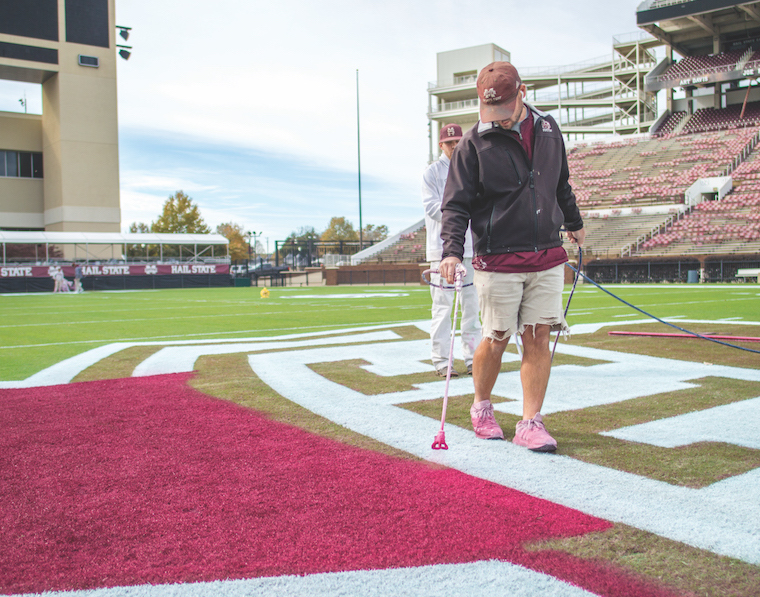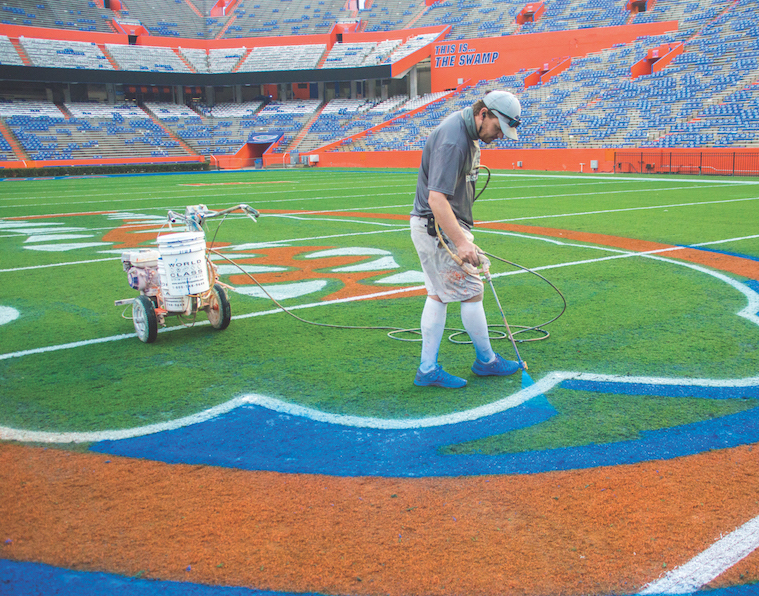For field paint trends, paint selection advice, application tips and more, SportsField Management recently interviewed Greg Narmour, vice president at World Class Athletic Surfaces.
SportsField Management (SFM): What are the latest trends/innovations in field paint?
Narmour: Ready to use (RTU) premixed paints. Sports turf managers are being required to do more work with less help. With pre-mixed RTU paints, they are able to get more painting done with less time and labor mixing it themselves. Also, bulk tote mixing systems using the RTU paints take it to another level. You can store more paint in less space and mix with a flip of a switch. If you take the hours that you would normally spend mixing paint, you can spend those same hours working on your fields, and that’s the most important aspect of a sports field manager’s job. There are also paints out now that will dry and cure faster. They can be useful to get the job done in cold and wet situations.
SFM: What recommendations do you have for sports field managers when it comes to selecting the right paint to meet their needs?
Narmour: Use water-based 100-percent acrylic latex paint. Avoid vinyl acrylics if at all possible. Avoid using a product that has a large amount of calcium carbonate. A small amount is okay and helps with hiding, but too much can build up in areas that are painted a lot. High-quality paints will cost a little more up front, but if it lasts longer, stays brighter longer, then you will use less and paint less. In the long run, using a high-quality paint is a very important part of a sports field manager’s arsenal.
SFM: What should sports field managers know about painting natural grass playing surfaces versus painting synthetic turf?
Narmour: Different surfaces require different paints to get the job done. Painting on natural grass and synthetic can be done with the same equipment and doesn’t vary as far as the application. When considering what kind of paint to use on a synthetic playing field, consider the amount of time you want the paint to last. If it’s a multi-purpose field requiring you to change layouts, use a quality removable paint. You can paint your logo, or field layout, and when you need to change to the next sport, you spray a special remover and wash it off. Remember that nothing will stick permanently to the synthetic surface, but the ease of removal at a specific timeframe is a plus with the special removable paints. One sports field manager told me that the best paint remover for any surface is a halftime show with a lot of feet.
SFM: What advice/tips do you have regarding application best practices and/or method of application?

Narmour: Remember that too much of anything is not good for the paint. Even too much water is not good. Restrain from over painting, especially when you see a little grass peeking out (that’s a good thing). Ninety-nine percent of the viewers will not see that from their vantage point. Use a quality water-based paint and quality airless sprayers. Use the correct tips and pressure for the job you are doing. Using the same tip you fill an end zone with and hash marks will waste paint. Using too much pressure will waste paint as well. You just want to paint the top parts of the grass; it’s a waste to paint the thatch, and will lead to a build-up. Do your best to knock off the dew prior to painting – painting on wet grass just prolongs the drying time and dilutes the paint even more.
Mow prior to painting, not after. You will just mow off the paint too soon. Also, water after mowing and before painting. Remember, the plant is going to want to absorb something after being mowed, and by watering after mowing and before painting you will end up using less paint and get a better look. Manage your time – be finished painting for the day prior to sundown so your paint is dry before dark. If it’s not dry before sundown, it will not dry or cure until the next day when the sun comes out. Also, the dew overnight will dilute your paint finish. If you are painting a two-coat project, make sure the first coat is dry prior to application of the second.
Manage your inventory so you don’t have paint sitting around too long. Field marking paint is best closest to the time it was made. Store your paint properly so not to be exposed to extreme heat or cold. Strain the paint every time you load your sprayer, if possible. Even a small piece of grass can clog a sprayer and interrupt your painting.
SFM: What should sports field managers know regarding the various grades of paint?
Narmour: There are many different grades and types of field marking paint, too many to list here. Some jobs, such as a practice field, could be done with one grade and the game field can be done with another. Using just one product that can be used at different mixing ratios for different fields may be beneficial. The best way to make sure you get a quality product is to build a relationship with your salesperson and/or paint company. With a good trusting relationship, they will make sure you get the product you need for your particular job.
Whether you use a concentrated paint or a premixed RTU paint, use a quality product that you will use less of. Using more of a lower-grade product for it to look like you want, there will eventually be build-up, which will be harmful to your grass in the long run. Use a product you are comfortable with and have had a good experience with. Reach out to your colleagues and peers on their experiences with different grades. They would be the best source and help you find the grade you are looking for.
SFM: What advice do you have regarding the creation of logos and/or the use of stencils?
Narmour: Using high-quality artwork will turn out the best-looking colorful stencils. Avoid getting too complex with really small details, as they will be hard to see from the vantage point of the viewers. Logos with white and lighter colors show up best on the green grass. Dark colors and black tend to show up better with a white border around them. An outside border will also make your logo pop.
Use a stencil made of quality plastic. If it’s too thin, the wind will cause you trouble and won’t last very long. Avoid going too small to save a dollar. It may look big to you standing on or near it, but from the viewers’ standpoint, it will look too small. For reference, the numbers on the field are usually 6 feet tall. You may think a 6-foot logo would be okay, but it would be a really small logo. When using stencils, do not leave them on the grass for more than an hour if possible. Make sure it is dry before folding or rolling it up. Store covered and out of the sun and elements. I like to fold once in half, then roll up on a PVC or corrugated type pipe and hang on hooks on the shop wall. This method takes up less storage and rolls right out just like you rolled it up. It also decreases the many folds in the stencil.


